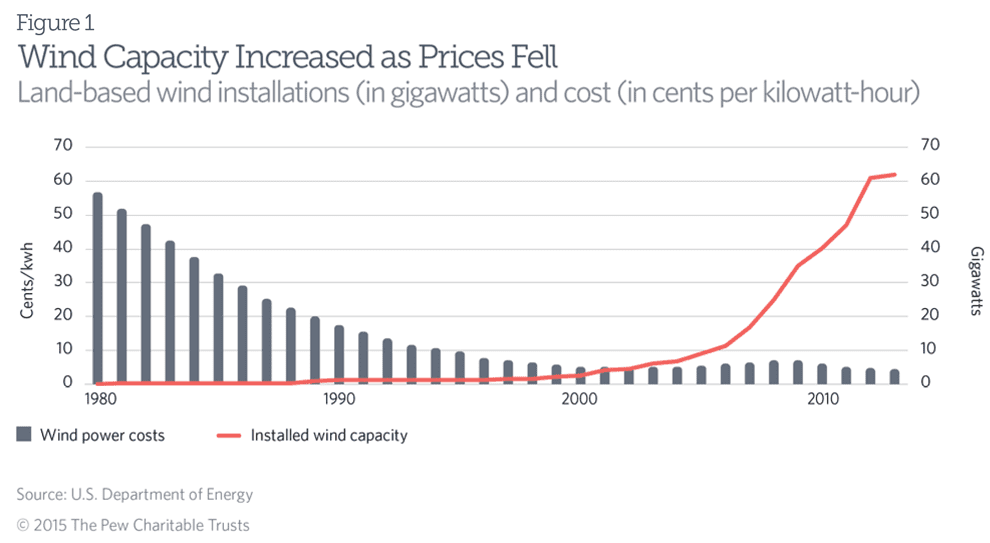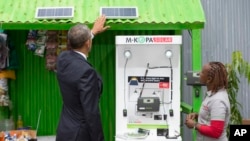by Steven Hayward at Powerline blog

Not working

Read more @ Renewable Energy: Still Breaking Wind | Power Line


Not working

Read more @ Renewable Energy: Still Breaking Wind | Power Line
Follow along with the video below to see how to install our site as a web app on your home screen.

Note: This feature currently requires accessing the site using the built-in Safari browser.



Google Senior Vice President of Technical Infrastructure Urs Hölzle said renewable energy will power Google’s data centers and offices around the world. According to the post, Google uses incredible amounts of energy to process trillions of searches per year. On Google’s YouTube video platform, people upload 400 hours of video every minute, the company said. “Our engineers have spent years perfecting Google's data centers, making them 50 percent more energy efficient than the industry average,” Hölzle wrote. “But we still need a lot of energy to power the products and services that our users depend on.”

Cattle graze in a pasture against a backdrop of wind turbines near Vesper, Kansas
He added that the company has been buying renewable energy since 2010 when it bought “all the electricity” produced by a 114-megawatt wind farm in Iowa. “Today, we are the world’s largest corporate buyer of renewable power, with commitments reaching 2.6 gigawatts (2,600 megawatts) of wind and solar energy,” Hölzle wrote.
Google says the price of renewable energy is falling, citing that wind and solar have become 60 and 80 percent cheaper respectively. Google said the company is involved in 20 renewable energy projects worldwide.
Google Says Will Use 100 Percent Renewable Energy by 2017
LOL A very funny read four years later. What a dumbass that wrote that.by Steven Hayward at Powerline blog

Not working

Read more @ Renewable Energy: Still Breaking Wind | Power Line


But today the community, south of Nairobi in the Rift Valley, is buzzing with solar and wind energy, which powers everything from the dispensary and church to shops, homes and even a rescue center for girls fleeing child marriage and the threat of female genital mutilation. Residents say they banded together to buy the shared energy system themselves, recognizing that the substantial upfront cost would create benefits for years to come. Those now include everything from vaccines that can now be kept cold at the dispensary to solar-powered pumping of water. "Before we started this solar farm, people from this village used to travel to Ngong town, which is 17 kilometers away, to get basic services and goods such as a photocopy or a haircut. This used to inconvenience us greatly, since you had to part with a tidy sum," said Simon Parkesian, the manager of the community's solar farm.
Residents chipped in
In 2009, some residents of Olosho-Oibor, impressed with the first couple of private solar panels installed in the community, decided they wanted panels of their own, but many people could not afford them. So a group of community members began contributing $10 a month each until they had enough to buy a set of larger solar panels that could serve many nearby homes. They then approached the U.N. Industrial Development Organization for technical help in installing their system. Today, the 125-member energy cooperative has raised $4,900 for panels installed on poles around the community and on rooftops and has installed two small wind turbines as well.

Then-President Barack Obama looks at a solar power exhibit during a tour of the Power Africa Innovation Fair, July 25, 2015, in Nairobi, Kenya. With technical help from the U.N. Industrial Development Organization, a cooperative in Olosho-Oibor installed solar panels on poles around the community and on rooftops. It has installed two small wind turbines as well.
The community also has a 10-kilowatt diesel generator as a backup in periods when sunshine and wind fall short, Parkesian said. Lydia Mboyo, one of those receiving power from the community energy farm, said having lights in the evening has helped her children study and has allowed her to run her small retail shop at night. She now is planning to expand her shop and buy a refrigerator to store perishable food and drinks. "I am also a member of a women's group that makes and sells beaded ornaments abroad, and with lighting we have been able to store our business records in computers. We also listen to the radio for entertainment while beading," Mboyo said.
Technology center
Parkesian said access to power also has spurred creation of a community information and communications technology center that has trained more than 40 people in basic computer skills, and that now offers photocopying and printing services. The center also allows people to charge their mobile phones, which once had to be switched off to save power when not being used to make calls.
As well, the renewable energy network is powering a center for vulnerable girls fleeing early marriage and female genital mutilation, "both problems common in the area," Parkesian said. "The power grid has initiated many projects in the community, but the most important project is the girls' rescue center that houses close to 80 vulnerable girls," he said. The center, opened in 2012, uses renewable energy to light its dormitories and classrooms.
Jackline Mwendo, a nurse at Olosho-Olbor dispensary, said her facility has been able to offer vaccine services since it got power to provide refrigeration. The dispensary's water supply has also improved as a result of using solar-powered pumps, she said, though she is still hoping for additional power to light maternal delivery rooms at night. Parkesian said the cost of maintaining the renewable mini-grid has been significant, and community members have needed to contribute $5 a month for continuing access to power to help pay those costs.
Technical knowledge needed
The court on Thursday ceded control of Oil Prospecting License 245 to the government while the West African country's Economic and Financial Crimes Commission investigates and prosecutes suspects in the "Malabu Oil scam," according to a statement from the commission. The commission's petition to the court says Dutch-British corporation Shell and Italian Agip — now Eni — bought the bloc in 2011 knowing the transaction was "fraught with fraud" and that the $1.2 billion payment to former petroleum minister Dan Etete and his allies was a bribe. The state oil company got only $210 million from the deal. The government is preparing further charges of "conspiracy, bribery, official corruption and money-laundering" against Shell and Eni, the petition says.
Criminal charges already have been filed against both companies and several executives in an Italian court in Milan. "This is historic. Generations of Nigerians have been robbed of life-saving services while oil men have grown rich at their expense," said Simon Taylor of the anti-corruption body Global Witness. "Companies and their investors must understand they can no longer do backdoor deals with corrupt officials without paying a hefty price."
Eni has not received notification of the court order, spokesman Roberto Carlo Albini told The Associated Press. "Eni denies any wrongdoing," he said. Shell Nigeria spokesman Bamidele Olugbenga Odugbesan said he had no comment. The oil companies paid the $1.2 billion into a Nigerian government escrow account at the London branch of JPMorgan Chase, and former justice minister Mohammed Bello Adoke authorized its distribution.
The commission last month filed charges of fraud and money laundering against Etete, Adoke and businessman Aliyu Abubakar. The petition says Nigeria's former military dictator Gen. Sani Abacha and Etete used front men to form Malabu Oil and Gas Ltd. and illegally awarded themselves OPL 245. After Abacha's mysterious death in 1998, the company directors and shareholding was fraudulently altered to divest Abacha's son, Mohammed, it says. The Malabu bloc was seized by the government once before, by the civilian government of Olusegun Obasanjo in 2001. Malabu Oil sued and an out of court agreement returned the bloc to the company.
Nigeria seizes $1.2 billion oil bloc in Shell, Eni scandal
 Will only double by 2050........not my projections but the projections in 2016 from the Obama administration.
Will only double by 2050........not my projections but the projections in 2016 from the Obama administration.

 All fuckery all the time.
All fuckery all the time.

 Obliterates ALL of the arguments of the warmist k00ks.
Obliterates ALL of the arguments of the warmist k00ks.
yep, wind mills proceeded horse drawn buggies, nice way to take a modern society back to just after the stone age, wind mills!Bring back the buggy whip. Damned horseless carriages ain't never going to amount to nothin'.
Translation: wind mills wear out faster than you think. Dr John Constable, director of Renewable Energy Foundation, commented: “This study confirms suspicions that decades of generous subsidies to the wind industry have failed to encourage the innovation needed to make the sector competitive. Bluntly, wind turbines onshore and offshore still cost too much and wear out far too quickly to offer the developing world a realistic alternative to coal.”
Abandoned Wind Farm in Hawaii
Is this true for wind installations in the US? No idea, but I have noticed for long time now that when I drive through California’s Tehachapi Pass on Hwy 58 (as I did again just the other day), you can see a lot of old, 1970s-era windmills still sitting at top ridges, but not operating any more. Apparently a lot of them were put up by wind power ventures, enticed by federal tax credits and subsidies that started back under Jimmy Carter, and California tax credits and subsidies started under Governor-for-Life Jerry Brown, and now there’s no one to take responsibility for taking them down. According to one estimate, there are 14,000 abandoned windmills in the U.S., though this number is disputed, though even wind defenders acknowledge there are “derelict” wind mills in California.

Renewable Energy sources are built only using Fossil Fuels. Increasing the use of Fossil Fuels to build huge monstrosities that produce very little energy is an extreme waste of Fossil Fuels.There's no reason we can't have both. Let's let the technology mature and the market decide when and how to implement renewable energy sources. Until then, let's continue researching and developing ways to use less fossil fuels more effectively and safely.
Silly ass, the B-17's built in the Boeing plant in Seattle were built with renewable energy. And electricity is electricity, it does not care how it is generated. So, electricity from wind can be used to build solar panels and wind mill parts just as easily as electricity from coal and gas plants.Renewable Energy sources are built only using Fossil Fuels. Increasing the use of Fossil Fuels to build huge monstrosities that produce very little energy is an extreme waste of Fossil Fuels.There's no reason we can't have both. Let's let the technology mature and the market decide when and how to implement renewable energy sources. Until then, let's continue researching and developing ways to use less fossil fuels more effectively and safely.
If you are going to offer commentary you should think it through, that which you propose.
Nobody who supports Renewables every considers how they are manufactured.
No dumb ass, they were built with Hydro-Electric, you know big dams. Dams, that have caused the failure of Venezuela's economy and cause all the blackouts across Brazil.Silly ass, the B-17's built in the Boeing plant in Seattle were built with renewable energy. And electricity is electricity, it does not care how it is generated. So, electricity from wind can be used to build solar panels and wind mill parts just as easily as electricity from coal and gas plants.
Last I checked, all metal and aluminum is made with Coal, old crock, your are about as stupid as they get.Silly ass, the B-17's built in the Boeing plant in Seattle were built with renewable energy. And electricity is electricity, it does not care how it is generated. So, electricity from wind can be used to build solar panels and wind mill parts just as easily as electricity from coal and gas plants.
What the fuck are you trying to say?No dumb ass, they were built with Hydro-Electric, you know big dams. Dams, that have caused the failure of Venezuela's economy and cause all the blackouts across Brazil.Silly ass, the B-17's built in the Boeing plant in Seattle were built with renewable energy. And electricity is electricity, it does not care how it is generated. So, electricity from wind can be used to build solar panels and wind mill parts just as easily as electricity from coal and gas plants.
And, no, you can not build Solar Panels with Solar Power, it is not strong enough, not now, not never. If it was they would already be doing it.
Oh, and very sneaky, right, to state "Wind Mill Parts", because everyone knows you need Coal to build a Wind Turbine! Yea, maybe you could build, well, never mind, you can not build anything on Wind Mill with the electricity it generates. That is why they only advertise a Wind Turbine as providing the Electricity for 10 or 20 houses, NOT INDUSTRY!
